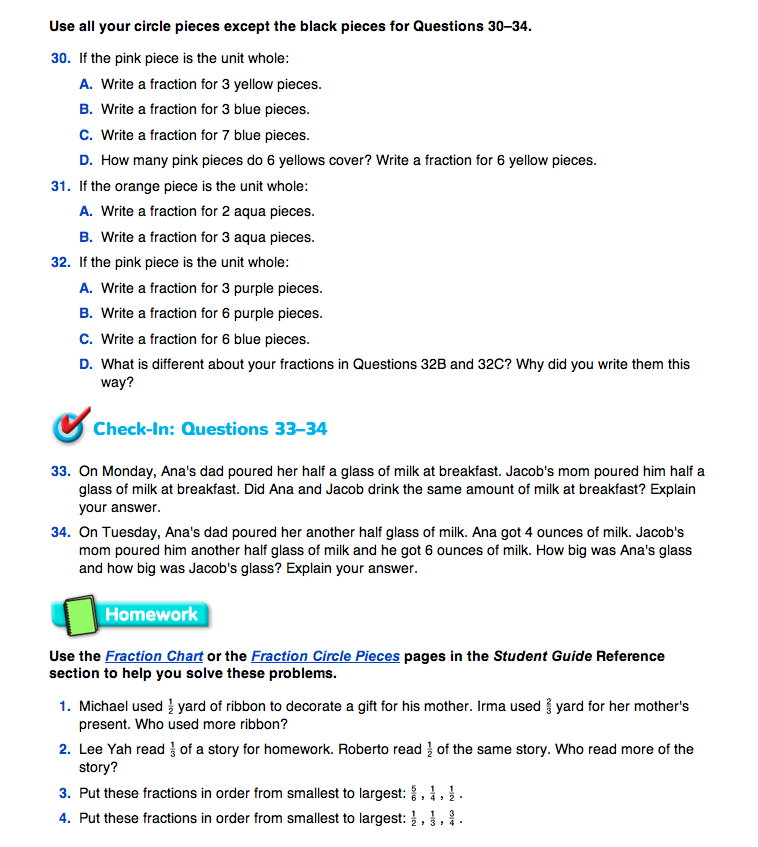To introduce Questions 30–34, pose the following problem:
Mrs. Dewey brought muffins to school for the students. Since they were large muffins, she cut each muffin in half. Michael, Irma, Roberto, Lee Yah, Nicholas, and Jessie were sitting at one table. They wanted to know how many muffins they would have if they put their muffin halves together.
Ask discussion questions similar to these:
- How many halves do the students have? (6 halves)
- How would you write that as a fraction? (6/2)
- How did you get 2 for the denominator? (Because each muffin was cut into 2 equal pieces, we are talking about halves.)
- How did you get 6 for the numerator? (That's how many halves they had.)
- What is the unit whole in this problem? (one muffin)
- How many muffins did it take to make the 6 halves? (3 muffins)
- How do you know? (2 halves make one muffin, so 6 halves would make 3 muffins.)
- Write an addition number sentence to match this problem. (1/2 + 1/2 + 1/2 + 1/2 + 1/2 + 1/2 = 6/2)
- Write a multiplication number sentence to match this problem. (6 × 1/2 = 6/2)
- Is 1/2 + 1/2 + 1/2 + 1/2 + 1/2 + 1/2 = 6 × 1/2 a true number sentence? (yes)
- Keenya, Luis, and Ana were at another table and asked the same question about their muffins. How many halves do they have? (3 halves)
- What is that as a fraction? (3/2)
- How do you know? (The denominator is 2 because we are still talking about halves; the numerator is 3 because they had 3 halves.)
- How many muffins did it take to serve Keenya, Luis, and Ana? (one whole muffin and half of another one, or 11/2 muffins)
- Write an addition number sentence to match this problem. (1/2 + 1/2 + 1/2 = 3/2)
- Write a multiplication number sentence to match this problem. (1/2 × 3 = 3/2)
- Is 1/2 + 1/2 + 1/2 = 3 × 1/2 a true number sentence? (Yes)
Discuss the bullet points that precede Question 30 in the Student Guide with the class as a whole. Point out to students the terms improper fraction, in which the numerator is larger than the denominator, and mixed number, which is a number that has a whole number part and a fraction part.
- Why can we say that 2/2 is the same as one whole? (Because the whole is divided into two parts and we are talking about both of them.)
- Name other fractions that are the same as one whole. What if we had divided our whole into 3 equal parts? (3/3 is also the same as one whole; 4/4, 5/5, 6/6, etc.)
- Give an example of an improper fraction from the story of the muffins. (6/2 or 3/2)
- Give an example of a mixed number. (11/2)
Have students work in pairs to complete Questions 30–34. Remind them to note which piece is the unit whole for each series of problems. This information is given at the beginning of each numbered question.
You may now assign the remaining problem in the Homework section, Question 7.
Use Check-In: Questions 33–34 to assess students' abilities to recognize that the same fractional part of different-sized unit wholes are not equal [E3] and identify the unit whole when given a fractional part of a whole [E4].
Targeted practice for these skills and concepts is in the Lesson 7 Workshop.













